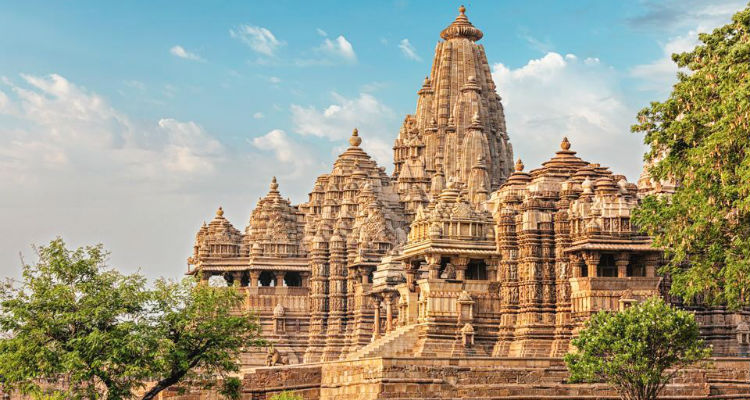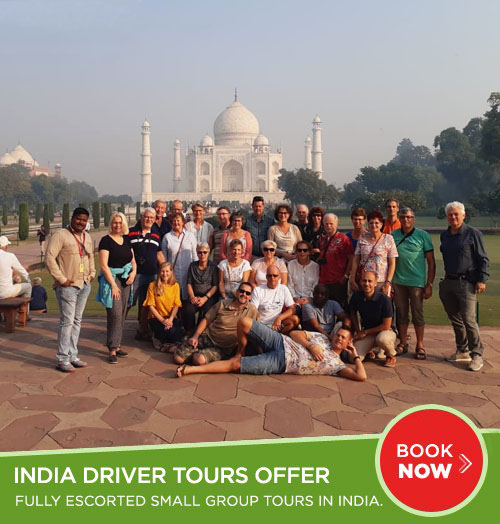
Khajuraho is a small town located in the Bundelkhand region (Chhatarpur District) of Madhya Pradesh and is famous for groups of Hindu and Jain temples. These temples are a UNESCO World Heritage Site for their beautiful and erotic rock carvings.
Khajuraho has the Vindhya range of mountains as its beautiful backdrop. This makes Khajuraho a particularly fascinating destination to visit.
Khajuraho’s art is a manifestation of the essence of the philosophy of Indian aesthetics. The erotic sculptures of Khajuraho depicting Kama Sutra are unique in the world. These sculptures representing the Indo-Aryan architecture, congeal in stone a lyrical paean to love and passion and reflect the Chandela dynasty’s passion and immense appreciation for the forbidden art, paradoxically, in the land of Kama Sutra. They cannot be passed off as just erotic sculptures, the temples have some of the most revered Gods of Hinduism.
History
The temples of Khajuraho were built between 950 to 1050 A.D. during the Chandela dynasty of Central India (These rulers claimed descent from the moon, hence the name Chand-ela). After the decline of the Chandela dynasty in 13th century, the temples were left under the cover of dense date palm trees for many years, which gave the city of Khajuraho its name, Khajur in Hindi means a date. In the ancient times it was known as Vatsa.
In 1838, a British army engineer, Captain T.S. Burt rediscovered them. By that time only 22 of the original 85 temples had survived.
Climate
Khajuraho’s climate is quite extreme, with wide variation in day and night temperatures along with minimal rainfall. Summers are hot at 45°C and winters pleasant at 27°C. Rainfall of 114 cms annually. As summer is too hot, winter is a good time to visit. A good time to visit is March, when the annual Dance Festival takes place. So the best time to visit Khajuraho is from September to March.
Places To Visit in Khajuraho
In every temple, there is the depiction of royalty, armies, wrestling, kinship, war, courtship, marriage, lovemaking, music and dancing, spiritual teachings, union, meditation, bliss, gods, goddesses, plants, animals and an abundance of all human forms.
Western Group of Temples
All the temples are open from sunrise to sunset. These are the richest and largest of all temple groups
Lakhmana Temple – The oldest and finest of the western group of temples, named after the ruler that built the temple. The A horizontal beam over the entrance of this beautiful Vaishnavite temple shows the trinity of Brahma, Vishnu and Shiva with Lakshmi, Vishnus consort.
Kandariya Mahadeo Temple – This temple is decorated with a profusion of sculptures that are among the greatest masterpieces of Indian art.
Devi Jagdamba Temple – Dedicated to the Goddess(devi), this is smaller and much more delicately proportioned temple and is home to some of the finest sculptures of Khajuraho.The garbha griha has a huge image of the Devi of the Universe (Jagdambi), though it appears to have started as a Vishnu temple. It has the usual three bands of sculptures, but the third and most uppermost of these houses some of the most erotic sculptures.
Chaunsat Yogini – The only granite temple in the Khajuraho group
Chitragupta Temple – is dedicated to the Sun God (Surya), it faces eastward to the rising sun
Matanageswara Temple – A temple dedicated to Shiva, a huge 8ft Lingam adorns the temple.
Varaha temple – dedicated to the Varaha avatar of Lord Vishnu, it holds the statue of a Vraha[boar] in the centrestage with the Sheshnag lying beneath. Carving of an idol of Devi Saraswati on the snout of the Varaha reflects that every word/sound[dhvani] seeks blessing of Devi Saraswati [Goddess of speech,learning and knowledge]
Vishwanath Temple – dedicated to Lord Shiva, also called Vishwanath [master of the universe]. In the same premises, a temple dedicated to Nandi, holds a huge statue of Nandi [the Bull, the companion, attendant and closest aide of Lord Shiva].
Eastern Group of Temples
Parsvanath Temple – Largest among the group, with exquisite carvings in detail. The sculptures on the northern outer wall are the highlights of this temple. The image was installed in 1860.The three roofs of this temple depict mixture of Hindu, Buddhist and Muslim influences.
Ghantai Temple – This Jain temple has a frieze which depicts the 16 dreams of Mahavira’s mother, and a jain goddess on a winged Garuda.
Adinath Temple – Dedicated to Jain Tirthankar(God), adinath, the temple is lavishly embellished with sculpted figures, including yakshis.
Hanuman Temple
Brahma Temple – considered to be one of the oldest temples of Khajuraho made entirely in granite and sandstone, is dedicated to Vishnu.
Vamana Temple – is the dwarf form of Lord Vishnu, located in a secluded place and is known for its simple architecture.
Javari Temple
Southern Group of Temples
Dulhadev Temple – The last temple of Khajuraho, lies to the south of Ghantai temple. The temple enshrines a Shivalingam. The apsara and ornamented figures are the temple’s most striking features.
Beejamandal Temple – It is a ruined temple, and is near the Chattarbhuj Temple
Chattarbhuj Temple Or The Jatkari Temple – Built in 1100 A.D., is well-known for its architecture, and is also the only temple to be devoid of any erotic sculpture. 3 km away from the Eastern Group. Facing West, have to take 10 steps to reach the sanctum. The massive 9 feet intricately carved Vishnu idol in Chaturbhuja (four-armed).
Light and Sound Show at Western group of temples – After visiting the temple complex is over, the sound and light show, narrated by the Bollywood icon Amitabh Bachhan, is held every evening.
Khajuraho Dance Festival


